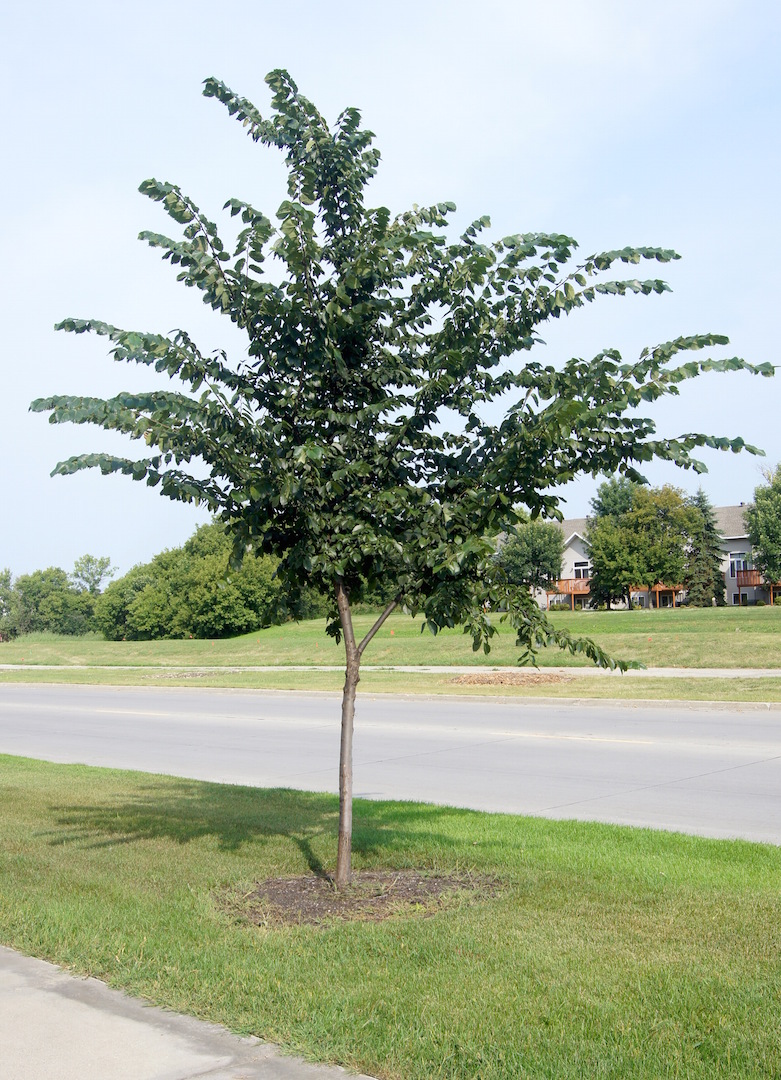Ulmus / Elm
uLMUS / ELM
Elms are loved for their graceful, stately shape, with branches like spreading fountains, and their green leaves that turn gold in fall. Sadly, the American elm (Ulmus americana) is often no longer recommended because it is vulnerable to a devastating pathogen called Dutch elm disease. However, due in part to research at The Morton Arboretum, other species and hybrids that are more resistant to the disease are available for planting. The biggest lesson learned from the devastation of Dutch elm disease is the importance of having a variety of trees along streets, in parks, and in home landscapes so that no disease or pest that may arrive can kill a large proportion of the trees. When Dutch elm disease (which actually originated in Asia) spread to the US in the 1950s, it was able to mow down elm after elm through their grafted root systems or with the help of a beetle. Today, arborists and foresters are careful to plant a diverse range of trees that will not all be vulnerable to any particular pest, disease or weather conditions.
The above info taken from the Morton Arboretum website:
http://www.mortonarb.org/trees-plants/tree-plant-descriptions/american-elm
Prairie Expedition® American Elm
Ulmus americana 'Lewis & Clark'
Incredibly tough and cold hardy, this American elm native selection is a lone survivor among elm trees that died of Dutch elm disease near Fargo, ND. Displaying a high resistance to the disease, it averages three to four feet of growth annually. Dark green foliage on the classic elm vase shaped canopy will provide quick shade in a variety of locations from cold prairies to harsh urban environments. Hardy to USDA Zone 2b.
Height: 55 ft
Spread: 40 - 50 ft
Fall Color: Gold
USDA Zone: 3 - 9
“The upright, vase shaped canopy of the Elm make it a terrific street or boulevard tree.”
TRIUMPH ELM
Ulmus 'Morton Glossy
This selection resulted from a controlled cross between Vanguard™ elm and Accolade® elm, conducted by Dr. George Ware at the Morton Arboretum. It has an upright habit with strong branching, lustrous dark green foliage and excellent disease and pest resistance.
Height: 40 - 60 ft
Spread: 35 - 40 ft
Fall Color: Yellow
USDA Zone: 4 - 7
**Info taken from Bailey Nurseries, Inc.**
care and pruning:
POSITIVES:
The upright, vase-shaped canopy of the Elm make it a terrific street or boulevard tree. It's branches do not hang down and therefore are not a nuisance to parked cars and traffic. The American elm was the most popular tree to plant in the booming cities of the 19th century, so that by the 20th century many streets were lined with only elms and were shaded in summer by a cathedral-like ceiling of their branches. Rich green foliage grows at a rapid growth rate.
DRAWBACKS:
Perhaps the biggest known drawback to the Elm tree is the known disease of Dutch Elm. Caused by a fungus, this disease is introduced to healthy trees by a beetle that burrows into the trees soft cambium tissue under the bark. The beetle carries on its body, fungal spores that once in the tissues of the tree multiply and stop the tree from getting the water it needs. Beetles are small but visible easily with the naked eye.
Once the tree of choice many of the mature Elm trees in the Williston community have been removed due to their infestation of Dutch Elm Disease. At this time there is no known cure for Dutch Elm. However, NDSU released the Prairie Expedition a few years ago, and it has shown extreme resistance to Dutch Elm Disease.
PRUNING:
The optimal pruning time for Elm trees is late winter and early spring when the trees are dormant.
For more on identifying old wood and new wood see our page on care of woody plants.



